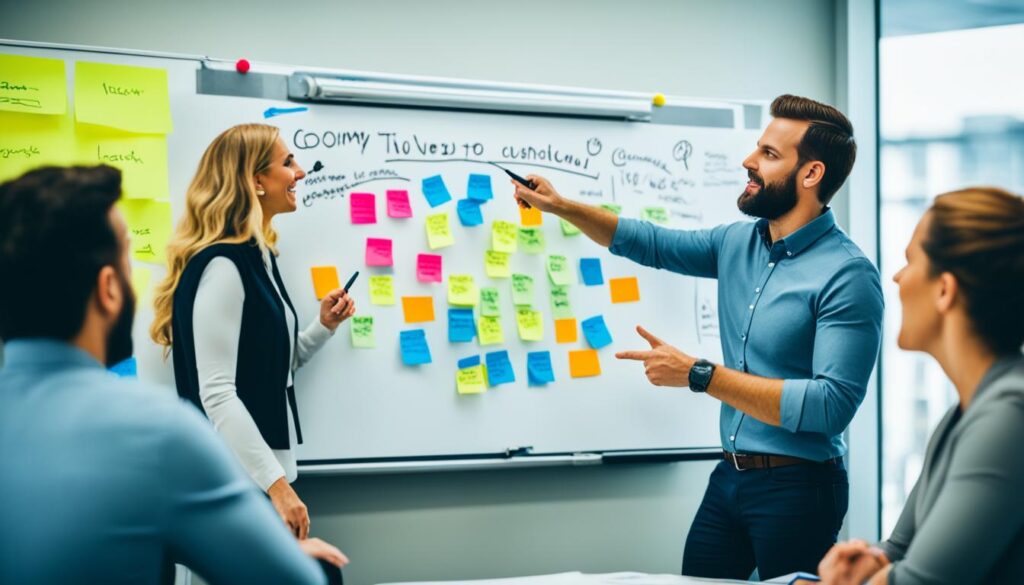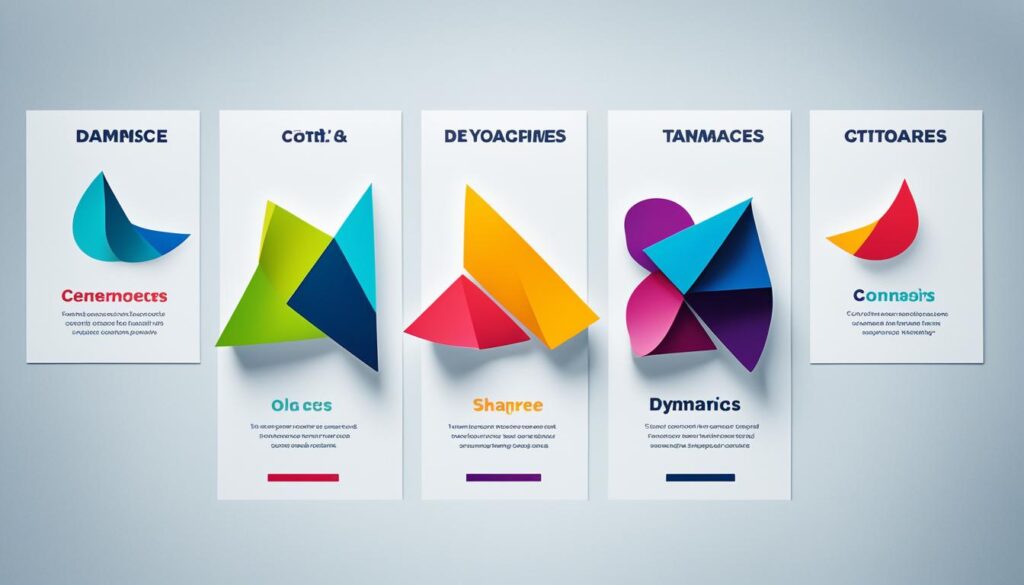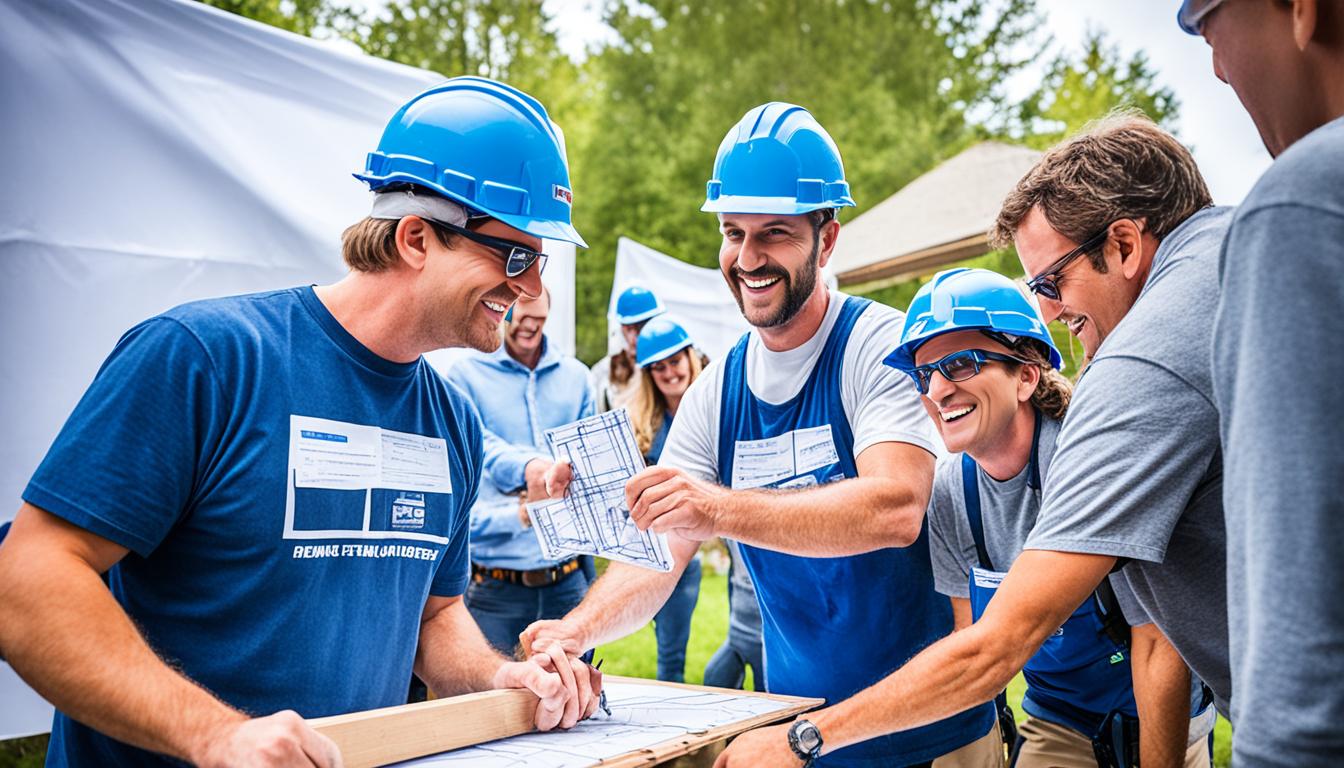Team dynamics are an integral part of achieving workplace success. Effective teamwork, communication, collaboration, leadership, conflict resolution, problem-solving, and group dynamics are vital skills that contribute to a productive and harmonious work environment. When team members possess these skills, they can achieve higher levels of innovation, productivity, and overall performance.
In this article, we will explore the importance of team dynamics and provide strategies to improve them. Whether you are a team leader or a team member, understanding and enhancing these skills will create a positive impact on your team’s dynamics and contribute to your organization’s success.
Key Takeaways:
- Strong team dynamics play a crucial role in workplace success.
- Effective communication, collaboration, and problem-solving are essential for fostering positive team dynamics.
- Leadership skills are important for guiding and inspiring teams towards common goals.
- Conflict resolution is key to maintaining healthy team dynamics and resolving issues constructively.
- Investing in team building activities can strengthen relationships and improve overall team dynamics.
What is Team Dynamics and Why is it Important?
Team dynamics in the workplace refer to how team members interact, communicate, and influence one another. It encompasses both formal aspects, such as roles and structure, and informal aspects, like relationships and communication styles. Effective team dynamics are crucial for workplace success as they contribute to enhanced collaboration, improved communication, higher morale, conflict resolution, accountability, and attracting/retaining talent.
Communication and collaboration are at the core of successful team dynamics. When team members communicate effectively, they share information, ideas, and feedback, leading to better decision-making and problem-solving. Collaboration, on the other hand, allows team members to pool their skills and knowledge, leveraging the power of collective intelligence to achieve shared goals.
Strong team dynamics also foster a positive and supportive work environment, promoting innovation and creativity. When team members feel comfortable sharing their ideas and perspectives, it leads to a culture of innovation where diverse thoughts and viewpoints can flourish.
Furthermore, effective team dynamics contribute to higher productivity by streamlining workflow and ensuring efficient task allocation. Team members who understand their roles and responsibilities are more likely to perform at their best, resulting in increased overall productivity.
In addition, team dynamics play a crucial role in conflict resolution. When there is open and respectful communication among team members, conflicts can be addressed promptly and resolved in a constructive manner. This not only prevents the escalation of conflicts but also contributes to a more harmonious work environment.
Lastly, team dynamics are vital for attracting and retaining talent. Organizations that foster a collaborative and supportive culture are more likely to attract top talent and maintain a high level of employee engagement and satisfaction.
Recognizing the importance of team dynamics, organizations invest in various strategies to foster a harmonious team environment. These strategies may include team-building activities, leadership development programs, communication training, and creating opportunities for collaboration and knowledge sharing.
Key Takeaways:
- Team dynamics refer to how team members interact, communicate, and influence one another.
- Effective team dynamics contribute to enhanced collaboration, improved communication, higher morale, conflict resolution, accountability, and attracting/retaining talent.
- Communication and collaboration are essential for successful team dynamics.
- Strong team dynamics foster a positive work environment, promote innovation, and increase productivity.
- Team dynamics play a crucial role in conflict resolution and talent attraction/retention.
Examples of Effective Team Dynamics
Effective team dynamics are crucial for optimizing performance and maintaining cohesion within a team. By examining successful examples of team dynamics, we can gain insights into how interactions among team members can positively influence overall team performance and effectiveness. Let’s explore five examples of effective team dynamics:
1. Collaborative Orchestra
The collaborative orchestra exemplifies the power of diverse skills and talents coming together to create harmonious innovation. Like the sections of an orchestra, team members with different expertise and strengths collaborate effectively to achieve a common goal. Each individual’s contribution blends seamlessly with others, resulting in a masterpiece of accomplishments.
2. Constructive Challenger
The constructive challenger is an essential element in driving critical thinking and innovation within a team. This team member challenges assumptions, encourages different perspectives, and fosters a culture of constructive feedback. By challenging the status quo and proposing new ideas, the constructive challenger inspires the team to explore creative solutions and overcome obstacles.
3. Synergy Spark
In a team with a synergy spark, team members inspire and motivate each other to achieve their full potential. This dynamic creates a positive and energizing atmosphere where individuals not only work collaboratively but also push one another to exceed expectations. By fostering a culture of encouragement and mentorship, the synergy spark unlocks the collective brilliance of the team.
4. Mentorship Nexus
The mentorship nexus represents a strong focus on knowledge sharing and growth within a team. Experienced team members take on the role of mentors, providing guidance, support, and opportunities for professional development to junior colleagues. This dynamic fosters a culture of continuous learning and helps individuals reach their potential while strengthening team cohesiveness.
5. Inclusion Initiator
The inclusion initiator ensures that all team members’ voices are heard and that diverse perspectives are embraced. By actively promoting inclusive practices and recognizing the value of different cultural backgrounds, the inclusion initiator fosters an environment where everyone feels valued and contributes authentically. This team dynamic allows for broader problem-solving, creativity, and innovation.
These examples of effective team dynamics illustrate how individual contributions and interactions shape the overall performance and success of a team. By nurturing these dynamics, organizations can create an environment that promotes collaboration, innovation, and high-performance. Additionally, fostering open communication and trust among team members is crucial in building a strong foundation for collaboration. Implementing enhancing team dynamics strategies, such as regular feedback sessions and team-building activities, can significantly improve relationships and productivity. When individuals feel valued and engaged, they are more likely to contribute their unique skills and perspectives, ultimately driving the team toward achieving its goals.

The Three Categories of Team Dynamics
Team dynamics play a crucial role in shaping the success of a team. To understand and manage team dynamics effectively, it is important to categorize them into three main categories: task-related dynamics, social dynamics, and individual dynamics.
Task-Related Dynamics
In task-related dynamics, team members collaborate to achieve common goals. This category focuses on various aspects such as roles and responsibilities, communication, decision-making, and conflict management. Effective task-related dynamics involve clear delegation of tasks, open and efficient communication channels, well-defined decision-making processes, and effective conflict resolution strategies.
Social Dynamics
Social dynamics involve the relationships and interactions among team members. It encompasses factors such as trust, cohesion, interpersonal relationships, and diversity/inclusion. Positive social dynamics contribute to a harmonious team environment where team members feel valued, supported, and included. This, in turn, fosters collaboration, creativity, and synergy among team members.
Individual Dynamics
Individual dynamics focus on the contributions and growth of each team member. It includes aspects such as motivation/engagement, skills/expertise, personal development, and recognition/feedback. Recognizing and harnessing the unique strengths and capabilities of individual team members promotes a sense of ownership, satisfaction, and continuous improvement within the team.
The understanding and effective management of these three categories of team dynamics are crucial for fostering a healthy and productive team environment. By addressing both task-related and social dynamics, while also nurturing the growth and development of individual team members, organizations can cultivate a strong and cohesive team that thrives in achieving its objectives.

Common Challenges in Achieving Positive Team Dynamics
Although positive team dynamics are important for workplace success, they can be challenging to achieve due to various factors. These challenges can hinder effective collaboration, productivity, and team spirit. In this section, we will discuss the common challenges that organizations face when trying to establish positive team dynamics.
1. Communication Barriers: Effective communication is essential for teamwork, but barriers such as language differences, unclear expectations, and poor listening can impede understanding and collaboration.
2. Conflicts and Disagreements: Conflicts and disagreements are inevitable in any team setting. However, unresolved conflicts can create tension and hinder team dynamics, affecting productivity and morale.
3. Lack of Trust: Trust is the foundation of strong team dynamics. When team members don’t trust each other, it can lead to miscommunication, low morale, and a lack of collaboration.
4. Underperformance: One underperforming team member can impact the overall team dynamics and hinder progress. It is crucial to address underperformance promptly to ensure the team stays on track towards its goals.
5. Team Member Turnover: High turnover rates can disrupt team dynamics as new members join and others leave. It takes time for new team members to integrate and adapt to the existing dynamics, potentially causing temporary disruptions.
To overcome these challenges and improve team dynamics, organizations must address communication issues, provide conflict resolution training, build trust through team-building activities, hold team members accountable for their actions, and effectively manage team member turnover.
Effective team dynamics require continuous effort and open communication. By addressing these challenges, organizations can pave the way for better collaboration, productivity, and overall workplace success.
Now, let’s explore some strategies to improve team dynamics in the next section.
Conclusion
In conclusion, effective team dynamics are essential for workplace success. By fostering collaboration, communication, and accountability, organizations can create a positive team environment that drives innovation and productivity. The strategies to improve team dynamics include establishing clear goals and expectations, promoting open communication and trust, encouraging diversity and inclusion, providing team building opportunities, resolving conflicts and misunderstandings, and navigating team member turnover. By actively engaging in these strategies, organizations can significantly enhance the performance and satisfaction of their teams. Moreover, investing in the development of team dynamics not only leads to improved outcomes but also cultivates a culture of continuous learning and adaptability. Ultimately, mastering team dynamics for success is a crucial element that enables organizations to thrive in an ever-evolving business landscape.
By implementing these strategies, organizations can enhance team dynamics skills and achieve their desired outcomes. Collaboration becomes stronger when team members have a clear understanding of their roles and responsibilities. Open communication and trust build a foundation for effective teamwork, while diversity and inclusion bring fresh perspectives and ideas to the table.
Resolving conflicts and misunderstandings in a timely manner fosters a harmonious work environment, and successfully navigating team member turnover ensures continuity and stability within the team. Leadership plays a crucial role in driving and maintaining positive team dynamics, as it sets the tone and provides guidance for the team’s interactions.
FAQ
What are team dynamics?
Team dynamics refer to the patterns of communication, cooperation, and collaboration within a team.
Why are team dynamics important in the workplace?
Team dynamics are important in the workplace because they impact productivity, innovation, and overall performance.
What are some examples of effective team dynamics?
Examples of effective team dynamics include the collaborative orchestra, the constructive challenger, the synergy spark, the mentorship nexus, and the inclusion initiator.
What are the three categories of team dynamics?
The three categories of team dynamics are task-related dynamics, social dynamics, and individual dynamics.
What are the common challenges in achieving positive team dynamics?
Common challenges in achieving positive team dynamics include communication barriers, conflicts and disagreements, lack of trust, underperformance, and team member turnover.
How can organizations improve team dynamics?
Organizations can improve team dynamics by establishing clear goals/expectations, promoting open communication/trust, encouraging diversity/inclusion, providing team building opportunities, resolving conflicts/misunderstandings, and navigating team member turnover.


